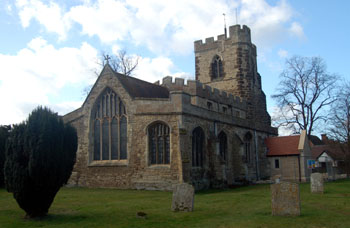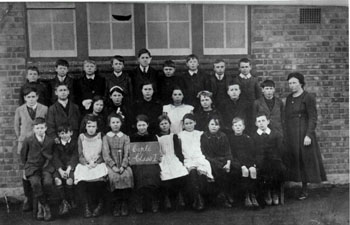
Cople church from the north-east February 2008
Volume 81 published by Bedfordshire Historical Records Society (2002) is a series of episcopal visitations edited by former County Archivist Patricia Bell. At each visitation a list of questions was sent out in advance, one of which enquired about the provision of schools in each parish. The various replies were as follows:
- 1706: "There is no Lecture, nor School in this parish...";
- 1709: "No public or charity Schole";
- 1717: "No School";
- 1720: "We have no such school"
In 1818 a Select Committee was established to enquire into educational provision for the poor. This was no doubt prompted in part by the recent foundation of two societies promoting education and specifically the building of schools. The Society for Promoting the Lancasterian System for the Education of the Poor was established in 1808, promoting schools run along the lines pioneered by Joseph Lancaster, who had himself copied those of Dr. Andrew Bell, in which older children taught their younger fellows. The Society was renamed the British and Foreign School Society in 1814. It was supported by a number of prominent nonconformists; Lancaster himself was a Quaker, and sought to teach a non-sectarian curriculum.
In answer to this perceived nonconformist takeover of local education the National Society was formed in 1811 to encourage the teaching of poor children along Anglican lines, including the catechism. The Select Committee sent a questionnaire to all parishes in the country asking for particulars relating to endowments for the education of children, other educational institutions, observations of parish needs, etc. Cople’s return read: ‘A charity school for 12 boys of this parish, and 6 of that of Willington, and a Sunday school, containing about 50 children, both supported by a voluntary subscription of £35 per annum.’ (In those days a Sunday School was just that, a school which met on a Sunday, usually in the church or nonconformist chapel or other similar building, teaching more than the religious topics with which they are associated today.) John Garbett, the minister, wrote that ‘the education of the poor is not properly provided for’.

A Cople School group about 1900 [Z50/33/4]
In the country generally the number of schools built continued to grow over the next fifteen years so that by 1833 the government agreed to supplement the work of the two societies, and local benefactors, by making £20,000 per annum available in grants to help build schools. It also prompted another questionnaire to be sent to each parish in England asking for details of local educational provision. In 1833 Cople (with population noted as 643) had a Daily School containing 45 boys and 8 girls. Instruction of 27 boys was paid for by voluntary contributions, and, of the remaining children, by their parents. There was also a Sunday school attended by 54 boys and 68 girls; it was supported by subscriptions.
A report of 1844 by the Rev. John Allen, a government inspector (one of only two at the time who were appointed by the Archbishops to inspect Church of England schools) noted that the Master was ‘left a good deal to himself, and appears to be doing his work with diligence’.
The next national enquiry was in 1846/7 when the Church of England made an enquiry as to all its church schools. This was against the background of a new Whig government which championed secular education, and the increasing importance of nonconformists, particularly Wesleyan Methodist and Roman Catholics, in providing schools. The Church School Inquiry of 1846/7 found that, in Cople, the Sunday school was attended by 60 children (24 boys, 36 girls) and the Daily school by 27 children (24 boys, 3 girls). It also recorded that the master ‘has his house from the Duke of Bedford rent free’. (When reading the Inquiry details, it must be kept in mind that they relate only to Church of England schools, and many parishes had nonconformist Sunday schools and a number of them day schools as well.)
In 1870, another government inspection by an Archbishop-appointed clergyman, the Rev. D.J. Stewart, ‘paid tribute to the positive contribution made by the Duke of Bedford in many parishes’, including the enlargement of the school building at Cople (amongst others), ‘for it was found that an unexpected number of children were forthcoming as soon as proper provision was made for their accommodation and instruction’.